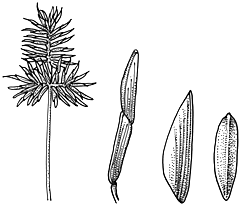Cyperus scaber (R.Br.) Boeckeler APNI* Synonyms: Cyperus cyperinus var. scabriculmis Kük. APNI*
Mariscus scaber R.Br. APNI*

Description: Tufted perennial with short thick rhizome.
Culms triquetrous, scabrous to hispid, swollen at base, 30–70 cm high, 1.5–2.5 mm diam.
Leaves septate-nodulose, shorter than culms, 4–8 mm wide. Inflorescence simple to compound, with 4–10 branches to 20 cm long; spikes cylindrical to ovoid, to 2 cm long and diam.; involucral bracts leaf-like, 3–6 longer than inflorescence. Spikelets terete, numerous per spike, 3–10 mm long, c. 0.7 mm diam., 1–4-flowered; rachilla broadly winged; spikelet falling as unit. Glumes remote, closely appressed to rachilla, obtuse, with sides 2–4-nerved, 2.5–3.5 mm long, yellow to pale brown. Stamens 3. Style 3-fid.
Nut trigonous, narrow-ellipsoid, about three-quarters as long as glume, c. 2 mm long, 0.5–0.7 mm diam., dark red-brown.
Flowering: spring–summer.
Distribution and occurrence: Grows in heath on coastal dunes; north from Pottsville.
NSW subdivisions: NC
Other Australian states: Qld
Distinctive amongst the few-flowered species in its scabrous to hispid culms and rachis of inflorescence, and its septate-nodulose leaves.
Text by K. L. Wilson
Taxon concept: Flora of NSW 4 (1993)
APNI* Provides a link to the Australian Plant Name Index (hosted by the Australian National Botanic Gardens) for comprehensive bibliographic data
***The AVH map option provides a detailed interactive Australia wide distribution map drawn from collections held by all major Australian herbaria participating in the Australian Virtual Herbarium project.
|


